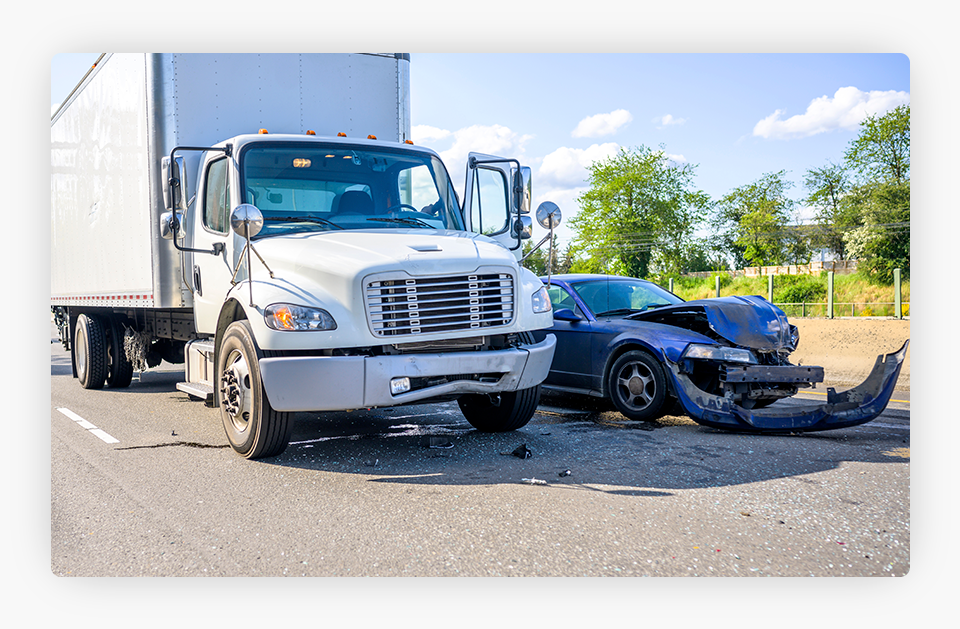We can’t send you updates from Justia Onward without your email.
Unsubscribe at any time.
A truck accident may plunge a victim into physical, emotional, and financial turmoil. While nothing can undo the crash, bringing a claim or lawsuit against anyone who was responsible can help blunt the blow.
When a truck strikes a passenger car, even greater harm may result than when two cars collide. Victims of truck accidents have a right to pursue compensation from anyone at fault. However, trucking companies and insurers often fight these cases fiercely. Before going deep into the process of filing a claim or lawsuit, an accident victim or their family may want to learn about some of the key laws and regulations in this area. The Truck Accidents Legal Center at Justia provides this information, as well as practical safety tips. Here are some answers to basic questions that might arise.

What Damages Can I Get for a Truck Accident?
Some common types of damages include medical bills, lost income from missed time at work, and vehicle repairs or replacement. Financial, relatively quantifiable items such as these are considered economic damages. A victim also may recover non-economic damages for more subjective forms of harm, such as pain and suffering and emotional distress. (Some states impose caps on these types of damages.) If a defendant engaged in serious wrongdoing, a victim might recover punitive damages as well. Rather than addressing the harm suffered by the victim, these damages aim to punish the defendant and deter others who might act similarly.
Whom Can I Sue After a Truck Accident?
While the truck driver may be the most obvious defendant, a victim also may have a claim against the trucking company that employed the driver. This may involve unsafe conduct by the company, such as putting a dangerous driver or truck on the road, or it may simply arise from the employment relationship between the trucker and the company. In other cases, a victim might sue the truck manufacturer if a defect in the truck contributed to the crash. They also might have claims against anyone who failed to take the appropriate care in maintaining or loading the truck. Cases involving a dangerous road may support claims against the government.
What Is the Statute of Limitations in a Truck Accident Lawsuit?
The statute of limitations is a filing deadline that a victim must meet to preserve their right to compensation. Each state has its own version of this rule, which typically is defined as a certain number of years after an accident. A defendant can ask the court to dismiss a case if the victim failed to comply with the statute of limitations, even if they otherwise could get compensation. If the victim is suing the government, they may need to file within a much shorter time.
How Do I Prove My Truck Accident Case?
Some potential forms of evidence in a truck accident case may include the police report on the accident, photos of the vehicles and the accident scene, information from the event data recorder (“black box”) in the truck, medical records, hospital bills, and pay stubs. Evidence also may include statements from people such as eyewitnesses who can recount the events leading to the accident, medical experts who can explain the prognosis for any long-term injuries, and family members and friends who can describe the impact of the accident on the victim’s life.

Should I Take a Settlement for My Truck Accident Case?
A settlement can resolve a claim and secure compensation sooner than if a victim takes the case to trial. Also, nobody knows for certain how a jury will view a particular case. A victim could go to trial, while incurring the extra cost that this involves, and end up with an amount of damages that is no greater (or even less) than what the defendant offered in a settlement. However, trucking companies and their insurers try to make cases go away as cheaply as possible. This means that the first settlement offer may not properly compensate a victim. They may go through several rounds of negotiations before getting a reasonable offer.
Who Pays for Injuries to a Truck Driver?
A trucker may be able to get workers’ compensation benefits if they were employed by the trucking company and injured in a crash while they were on the job. These benefits are generally available regardless of fault, which means that the driver likely could get them even if they caused the accident. However, they extend less broadly than the damages available in personal injury lawsuits. For example, workers’ compensation does not account for pain and suffering. If a third party other than their employer or a coworker bore some fault, therefore, a trucker might consider bringing a lawsuit against the third party as well.
Who Can Get Damages After a Fatal Truck Accident?
Certain family members of the victim may be able to recover damages after a fatal truck accident through a wrongful death lawsuit. Eligible people may include a spouse and children, as well as parents, siblings, grandparents, grandchildren, and anyone else who would be able to inherit from the deceased person under the default rules of intestate succession in the state. The estate of the victim also may have a claim for damages, which is often called a survival action. Family members may be able to recover damages for their loss of financial support from the victim and the intangible benefits of their relationship, while the estate may be able to recover damages for the victim’s medical bills, lost income, and sometimes pain and suffering.

How Does a Driver Get a CDL?
A prospective truck driver first needs to get a commercial learners permit by passing knowledge tests and a check of their driving record, among other requirements. While holding a permit, they can practice their skills behind the wheel of a truck while a licensed truck driver accompanies them. After at least 14 days with a permit, the driver can take a skills test. This consists of a vehicle inspection, a basic controls test, and a road test. Under federal regulations, a prospective trucker must complete a certain program that combines theory with behind-the-wheel instruction before taking the skills test.
How Long Can Truckers Stay on the Road?
Once a driver has had 10 consecutive hours off duty, they have a 14-hour period in which they can drive for no more than 11 hours. Afterward, they must have another 10 consecutive hours off duty before they can drive again. A driver also cannot take their truck out on the road once they have been on duty for 60 hours in seven days or 70 hours in eight days. Unfortunately, some truckers may succumb to pressure or incentives to violate these rules. Driver fatigue thus is one of the most common causes of truck accidents. A driver must keep an accurate log of their hours, but this rule sometimes goes unheeded.
Where Are the Blind Spots Around Trucks?
The blind spot in front of a truck extends for 20 feet, while the blind spot behind a truck extends for 30 feet. A truck also has a one-lane blind spot on the left side that extends from the driver’s mirror to the middle of the trailer. The blind spot on the right side spans different areas of two lanes. A driver in the lane next to the truck should avoid being even with the front of the cab, while a driver two lanes to the right of the truck should avoid being next to any part of the truck. However, truckers are expected to check their blind spots and may be held liable for failing to take this precaution.
Final Thoughts
Any motor vehicle collision can cause serious injuries, but this risk looms especially large in a truck accident. Many of these crashes result from errors or misconduct by a truck driver or trucking company, although sometimes other entities may bear the blame. If you are dealing with the aftermath of a devastating accident, you should contact a personal injury attorney to learn about your options and potential next steps.
In the meantime, the Truck Accidents Legal Center offers a readable overview of some key concepts in this area. Like the other Justia Legal Guides, it furthers our mission of making the law free and accessible to all.
Related Posts